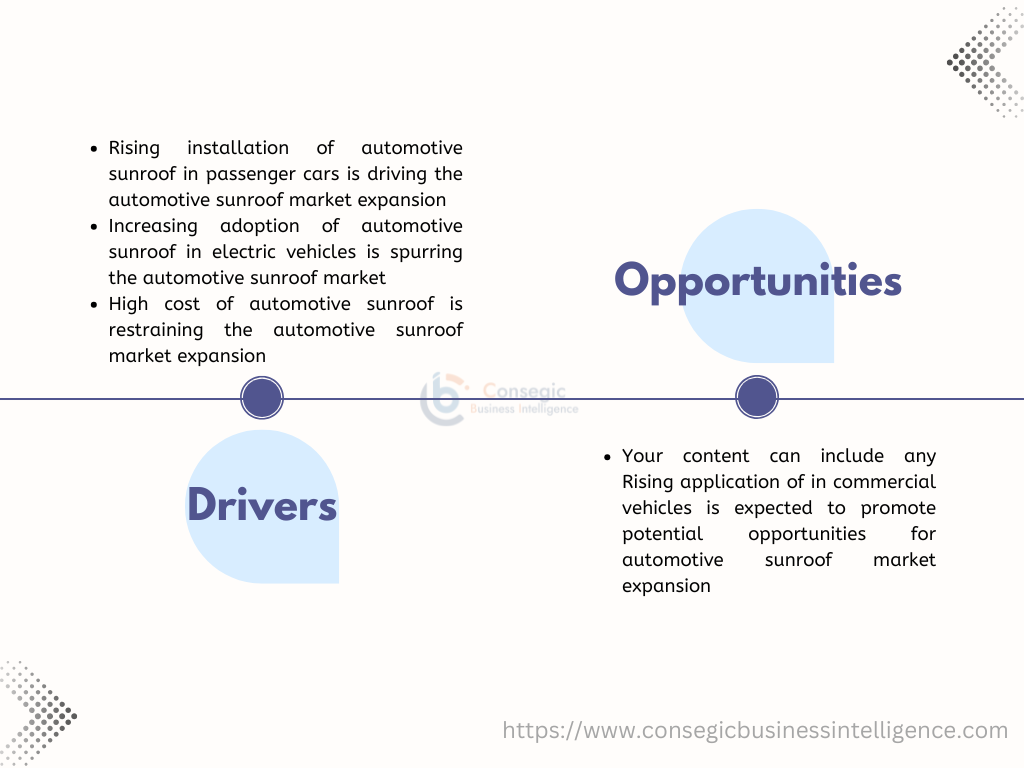- Summary
- Table Of Content
- Methodology
Automotive Sunroof Market Size:
Automotive Sunroof Market size is estimated to reach over USD 14,686.82 Million by 2032 from a value of USD 7,126.83 Million in 2024 and is projected to grow by USD 7,674.04 Million in 2025, growing at a CAGR of 9.5% from 2025 to 2032.
Automotive Sunroof Market Scope & Overview:
An automotive sunroof refers to a metal or glass panel that is integrated on the roof of a vehicle. The sunroof pops up or slides open to enable light and air into the interior of vehicle cabin. Sunroofs offer a remarkable view of the sky and enable passengers to enjoy the external view without any distractions.
Moreover, sunroofs promote air circulation in the car cabin and ensure proper ventilation in the car, which in turn enhances passenger comfort and convenience. The aforementioned benefits of sunroofs are key determinants for increasing their utilization in passenger cars, electric vehicles, and commercial vehicles.
Automotive Sunroof Market Insights:
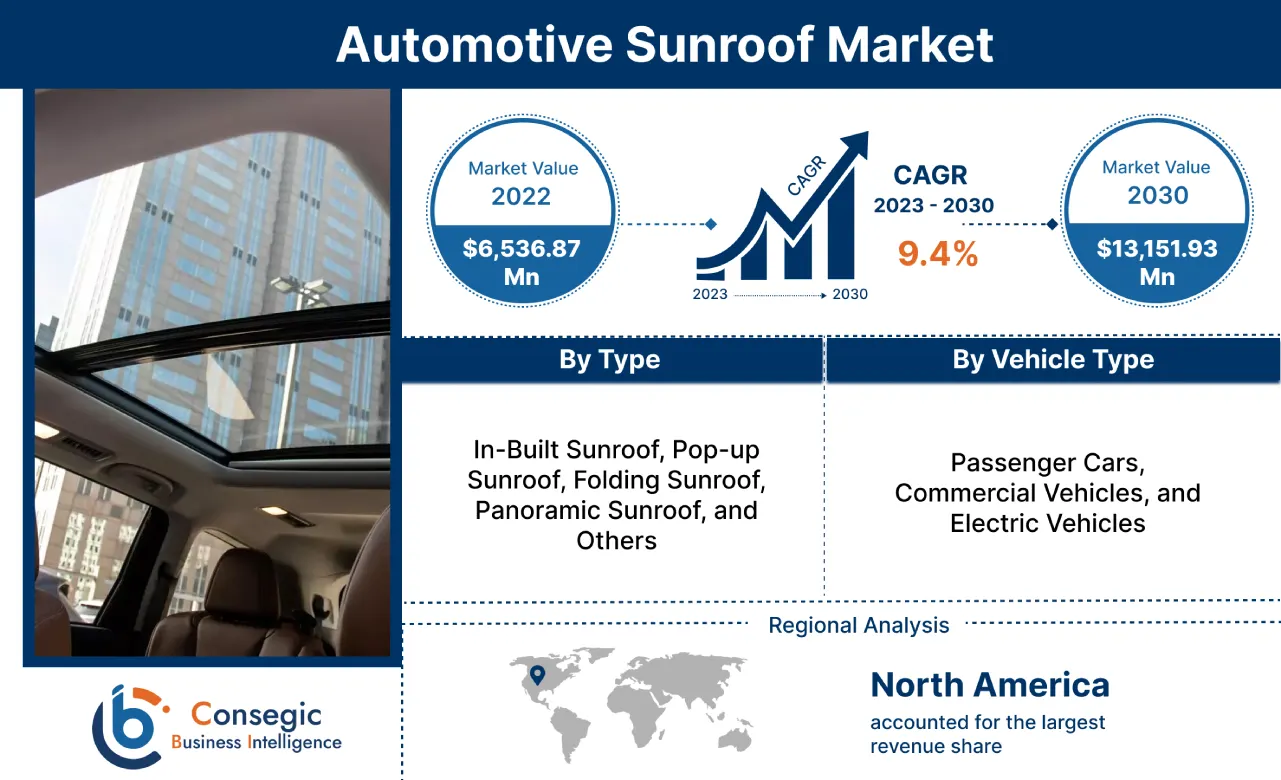
Automotive Sunroof Market Trends:
Advancements in Smart Glass Technology
Advanced sunroof systems are increasingly incorporating electrochromic glass, also known as smart glass. This technology allows the glass to automatically adjust its tint level based on sunlight intensity. It helps reduce heat buildup inside the vehicle and minimizes glare, improving passenger comfort and visibility.
The ability to control light transmission also contributes to better energy efficiency, especially in electric vehicles. In addition, solar-absorbing glass and photovoltaic roofs are gaining popularity, particularly in high-end and electric vehicles. These glass types absorb solar energy, helping regulate cabin temperature and reduce the load on air conditioning systems. Photovoltaic roofs go a step further by generating auxiliary power, which support interior electronics or ventilation systems. This feature aligns with the growing focus on sustainable and energy-efficient automotive solutions.
Increased Use of Lightweight and Durable Materials
OEMs are also prioritizing the use of lightweight, high-strength materials such as tempered glass and aluminum frames. These materials are designed to reduce overall vehicle weight, which supports improved fuel efficiency and performance. They offer enhanced structural integrity, making them safer and more durable.
The latest sunroof designs are engineered for thermal insulation and sound reduction, creating a more comfortable in-cabin experience for passengers. Overall, these innovations reflect the industry's shift toward smarter, safer, and more energy efficient sunroof systems that align with modern vehicle design trends and consumer expectations.
Rising installation of automotive sunroof in passenger cars is driving the automotive sunroof market expansion
Automotive sunroofs are mainly used in passenger cars to allow natural light and fresh air into the vehicle cabin through the roof. These sunroofs offer several benefits, such as better ventilation, improved aesthetics, greater visibility, and a more comfortable driving experience. These features are key reasons for their increasing use in modern passenger vehicles. The market growth is supported by rising disposable income, growing passenger car production, and a higher demand for thermal comfort inside vehicles.
- According to the International Organization of Motor Vehicle Manufacturers (OICA), global passenger car production reached 61.59 million units in 2022—an increase of nearly 8% from 57.05 million units in 2021.
As a result, the growing production of passenger cars is contributing to higher adoption of sunroofs, as manufacturers seek to enhance cabin comfort and ventilation. This trend is expected to continue driving market expansion.
Increasing adoption of automotive sunroof in electric vehicles is spurring the automotive sunroof market
The use of automotive sunroofs is becoming increasingly common in electric vehicles. Sunroofs offer multiple advantages such as a greater sense of space, better ventilation, emergency egress options, and improved thermal comfort. These benefits are key factors supporting their growing adoption in EVs. Additionally, electric vehicles often emphasize modern design and advanced features, making sunroofs a desirable inclusion. The increasing availability of EV models, along with their eco-friendly appeal and consumer demand for enhanced in-cabin comfort, are further accelerating sunroof integration.
- According to the International Energy Agency (IEA), global electric vehicle sales reached 2 million units in the first quarter of 2022. This represents a 75% increase compared to the same period in 2021.
The rapid growth in EV adoption is contributing to the rising demand for automotive sunroofs, as manufacturers look to offer premium features and meet evolving consumer expectations. This trend is expected to support further expansion of the sunroof market.
High cost of automotive sunroof is restraining the automotive sunroof market expansion
The adoption of automotive sunroofs is often limited by their high cost, which remains a key factor restricting market growth. The total cost of sunroof systems depends largely on production expenses and the price of raw materials such as glass, aluminium, and fabric. These materials contribute significantly to the final price of the product.
- For instance, Automotive Sunroof-Customcraft (ASC) Inc. offers its Signature series of in-built sunroofs at an average cost of approximately USD 1,016.35. Panoramic sunroofs are even more expensive, typically ranging from USD 1,500 to USD 3,000, depending on type and features.
Thus, high costs deter adoption, particularly in cost-sensitive markets, thereby limiting overall market expansion.
Future Opportunities :
Rising application of in commercial vehicles is expected to promote potential opportunities for automotive sunroof market expansion
The use of sunroofs in commercial vehicles is emerging as a promising growth opportunity for the automotive sunroof market. These systems are increasingly being integrated into buses, trucks, and utility vehicles to improve cabin ventilation and promote air circulation. The growing pace of industrialization, rising investments in commercial vehicle production, and demand for cost-efficient logistics solutions are key drivers supporting this trend.
- According to the International Organization of Motor Vehicle Manufacturers (OICA), global commercial vehicle production reached 23.42 million units in 2022, showing a 7.5% increase from 21.79 million units in 2020.
This rise in production is expected to boost sunroof installations in commercial fleets, opening up new avenues for market expansion in the forecast period.
Automotive Sunroof Market Segmental Analysis :
By Type :
Based on the type, the market is segmented into in-built sunroof, pop-up sunroof, folding sunroof, panoramic sunroof, and others.
In-built Sunroof
The in-built sunroof segment accounted for the largest revenue share in the year 2024. The in-built sunroof features a standard design and often slides between the car's metal roof and interior headliner. In-built sunroofs are usually integrated with a tilt feature, which enables the rear of the sunroof to be popped up for creating a small opening on the roof.
Based on the analysis, the primary benefit of an in-built sunroof is its ability to open completely, providing an enhanced aesthetic from the inside and outside of the car. The above benefits of in-built sunroofs are increasing its utilization in passenger cars among others. According to ACEA (European Automobile Manufacturers Association), the total production of passenger cars in the European Union reached up to 10.9 million in 2022, depicting a growth of 8.3% in comparison to 2021.
Hence, the rise in passenger car production is among the key factors driving the demand of in-built sunroofs, in turn contributing to the trends of the market.
Pop-up Sunroof
Pop-up sunroofs are the most basic type of sunroof system, typically manually operated and hinged at the rear, allowing the front of the panel to be lifted or tilted for ventilation. Some variants can be fully removed and stored. These sunroofs are lightweight, easy to install, and low-cost, making them popular in earlier vehicle models and in the aftermarket space for budget-conscious consumers.
Folding Sunroof
Folding sunroofs, also known as ragtop or cabrio sliding sunroofs, are typically made of fabric or vinyl and operate by sliding backward along a track, folding the soft material as they open. This style mimics the functionality of a convertible without fully retracting the roof, offering an open-air experience while preserving the vehicle's roof structure.
While folding sunroofs are fading from OEM lineups, they remain relevant in aftermarket upgrades and classic vehicle restorations. Their lightweight construction and simple mechanism also make them suitable for smaller EVs where weight and space constraints are critical design factors.
Panoramic Sunroof
The panoramic sunroof segment is anticipated to register fastest CAGR expansion during the forecast period. Panoramic sunroofs are designed for maximizing the upward view through the automobile's roof. Moreover, as per the analysis, a panoramic sunroof is a multi-panel sunroof that is capable of covering a large area, in turn providing fresh air and light throughout the vehicle cabin, which makes it ideal for utilization in passenger cars and electric vehicles.
For instance, according to the International Energy Agency, the total registration of electric cars in the United States reached 630 thousand units in 2021, depicting a significant expansion as compared to 295 thousand units in 2020.
Thus, the rising adoption of electric vehicles is fostering the demand for these sunroofs for providing ambient light and air into the vehicle cabin, thereby driving the market expansion during the forecast period.
By Material:
Based on the material, the market is segregated into glass sunroof and fabric sunroof.
Glass sunroof
Glass sunroofs segment accounted for the largest revenue share in the year 2024 due to their visual appeal, durability, and advanced functionality. Laminated and tempered glass varieties provide UV protection, improved acoustic insulation, and structural stability. Innovations like smart glass with electrochromic tinting, solar absorption, and light modulation are gaining ground, particularly in high-end vehicles and electric models.
OEMs such as Tesla and Lucid have embraced solar-absorbing glass roofs, integrating them into vehicle design to support both energy efficiency and aesthetic cohesion. As a result, the use of glass in sunroofs continues to grow, especially in markets that favor technological sophistication and comfort.
Fabric sunroof
Fabric sunroofs segment is expected to witness fastest CAGR growth during the forecast period. These sunroofs typically seen in convertible or folding-roof designs, have a niche presence in the modern market. While they evoke a classic or sporty appeal, especially in luxury sports models and vintage-styled cars, their demand is in decline.
Fabric materials are more vulnerable to wear and weather, making them less favorable compared to the increasingly versatile and resilient glass options. Still, some high-end or custom builds retain fabric sunroofs to preserve traditional aesthetics or provide a unique tactile experience.
By Vehicle Type:
Based on the vehicle type, the market is segregated into passenger cars, commercial vehicles, and electric vehicles.
Passenger Cars
The passenger cars segment accounted for the largest revenue share of 48.5% in the year 2024. Based on the analysis, factors including rising disposable income, increasing passenger car production, and growing need for thermal comfort and safety features in cars are among the key prospects driving the expansion of the passenger car segment.
According to the China Association of Automobile Manufacturers, the overall production of passenger cars in China reached up to 14.8 million units in January-August 2022, witnessing a YoY growth of 14.7%. Therefore, the rising production of passenger cars is driving the utilization of these sunroofs, attributing to its aesthetic appeal and ability to offer improved light and ventilation within car cabins.
Electric Vehicles
The electric vehicles segment is expected to witness fastest CAGR growth during the forecast period. The expansion of the electric vehicles segment is attributed to several factors including the advent of sustainable mobility, availability of a wide range of models, eco-friendliness, and the availability of tax rebates and subsidies on EVs.
For instance, according to the International Energy Agency (IEA), the new registrations of battery electric vehicles (BEVs) in Europe reached 1,231 thousand units in 2021, depicting an increase of 65% as compared to 746 thousand units in 2020.
Therefore, as per the analysis, the growing electric vehicle sector is driving the adoption of these sunroofs in modern EVs, in turn driving the automotive sunroof market trends.
Commercial Vehicles
Commercial vehicles are slowly beginning to integrate sunroof options, primarily in luxury vans and vehicles customized for tourism or executive transportation. While the overall adoption rate remains low, the trend is upward, particularly in lifestyle-oriented models aimed at enhancing passenger experience.
Sunroofs in CVs are used to elevate comfort and differentiate high-end variants, with brands like Mercedes-Benz and Toyota introducing models that feature built-in sunroof options in their people-mover offerings.
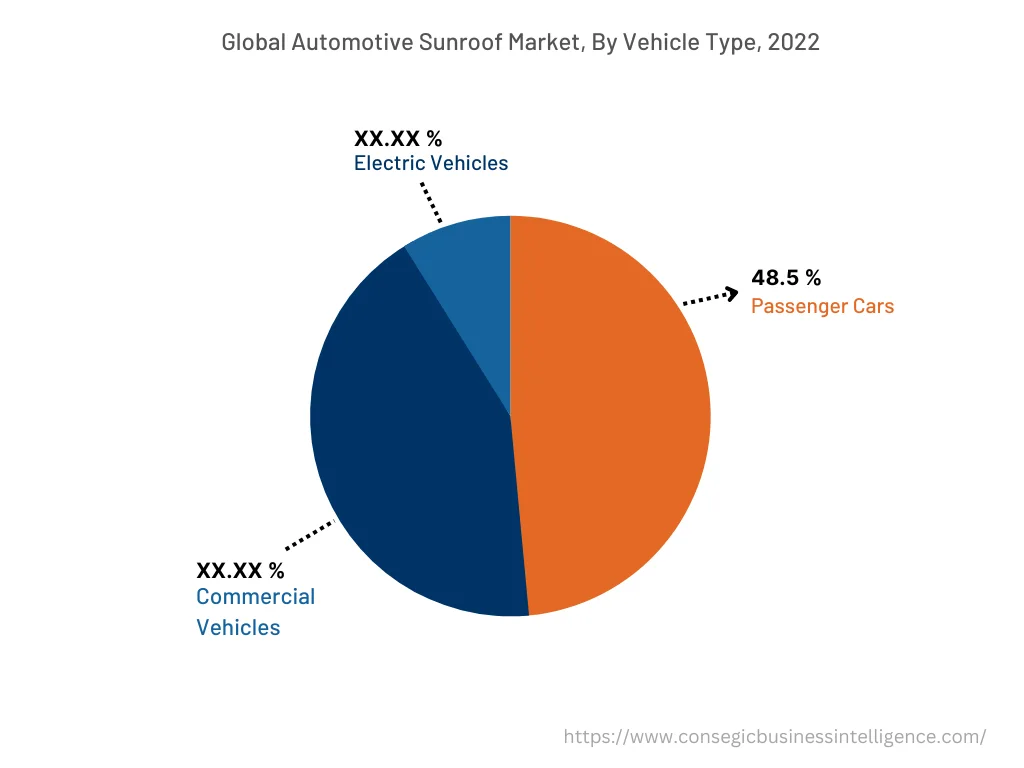
By Sales Channel:
Based on the sales channel, the market is segregated into OEMs and aftermarket.
OEMs
The OEM (Original Equipment Manufacturer) segment accounted for the largest revenue share in 2024. OEM sunroofs are integrated during vehicle production, offering better safety standards and quality assurance. Consumers also trust factory-installed features more than aftermarket alternatives.
Automakers are increasingly using sunroofs to add value and differentiate products, especially in mid-range models. These features are influencing purchase decisions in competitive markets. Regions such as Asia-Pacific and Europe show high OEM sunroof penetration. In China, over 35% of new vehicles sold in Tier-1 cities include a factory-installed sunroof.
Aftermarket
The aftermarket segment is projected to record the fastest CAGR during the forecast period. Aftermarket sunroof installations are common in regions like Latin America, Southeast Asia, and Eastern Europe. These areas have strong customization cultures and a large number of used vehicle owners.
Many customers opt for aftermarket sunroofs to enhance comfort and style without buying a new vehicle. While the aftermarket offers flexibility and cost benefits, it faces issues with safety, quality, and regulatory compliance. However, growing availability of panoramic retrofit kits and better installation services have helped sustain steady demand in this segment.
Regional Analysis:
The regional segment includes North America, Europe, Asia Pacific, Middle East and Africa, and Latin America.
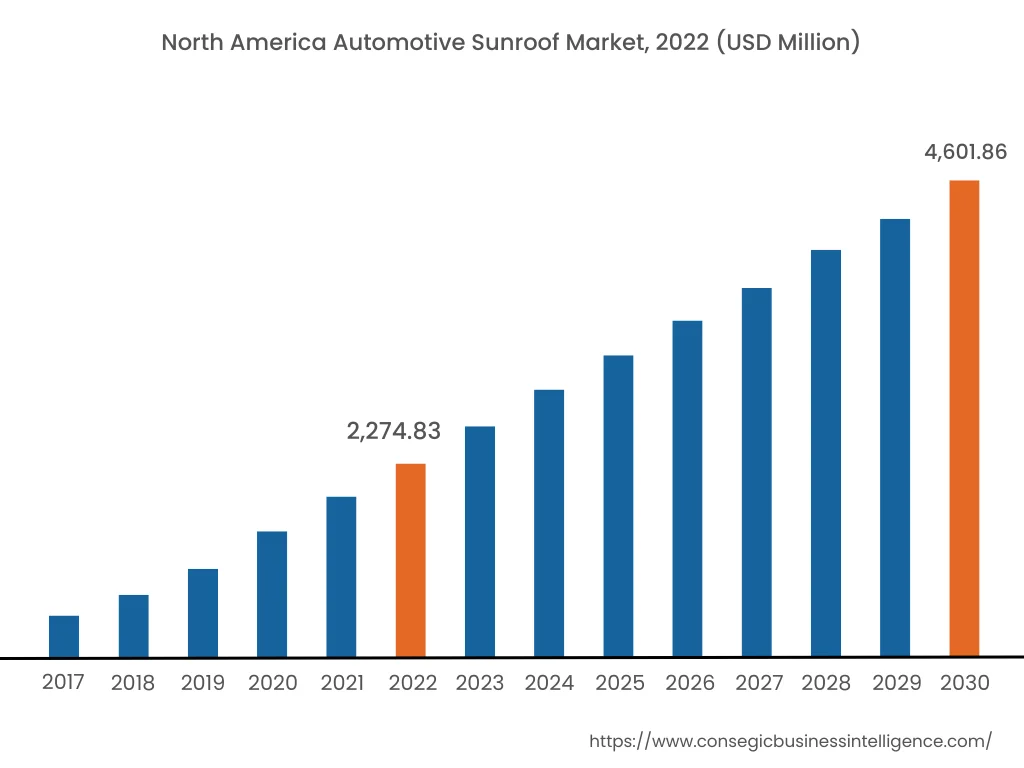
Asia Pacific
In Asia Pacific region, the market is estimated to reach over USD 4,472.14 million by 2032 from a value of USD 2,098.91 million in 2024 and is projected to grow by USD 2,266.46 million in 2025. Out of this, China contributed the highest share, accounting for 33.6% of the regional revenue. Rapid industrial development and urbanization are key drivers in this region.
Government support for the automotive sector and expansion of manufacturing capacity are boosting sunroof adoption. In addition, increasing EV production is creating new opportunities. For instance, passenger vehicle production in India grew by 25.4%, reaching 4.57 million units between April 2022 and March 2023, according to the Society of Indian Automobile Manufacturers.
This sharp rise in production is supporting the wider adoption of sunroof systems across multiple vehicle categories in Asia Pacific.
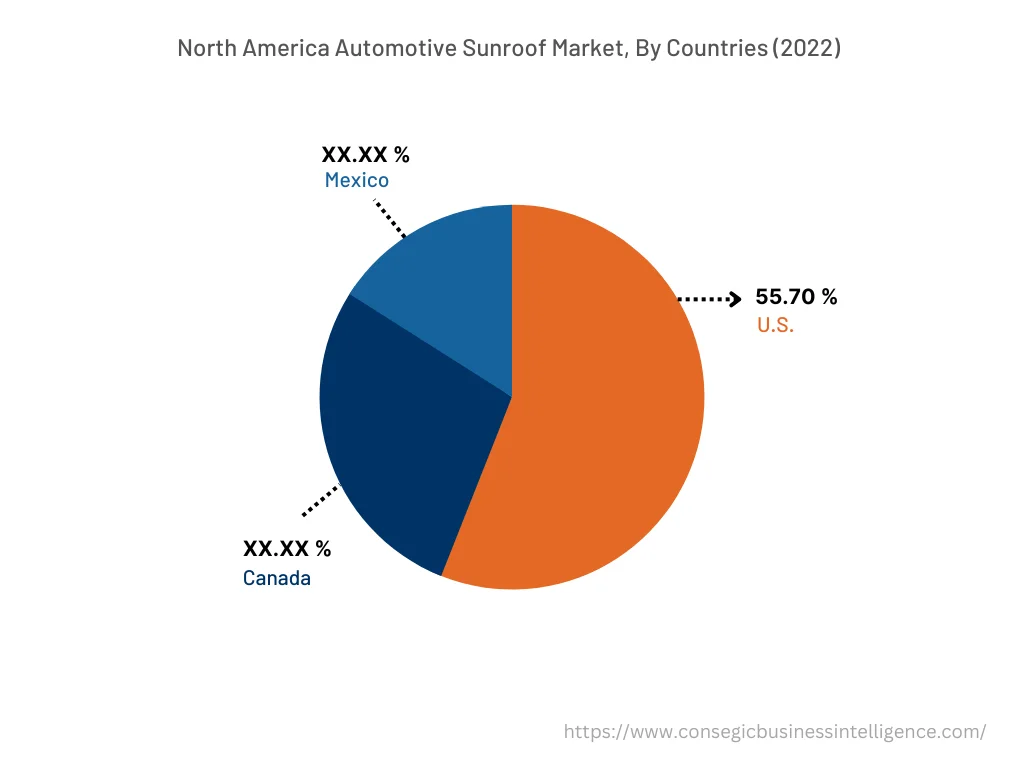
North America
North America market is estimated to reach over USD 4,760.00 million by 2032 from a value of USD 2,364.03 million in 2024 and is projected to grow by USD 2,540.68 million in 2025. Growth in this region is driven by increased investments in vehicle manufacturing and rising automotive production.
According to the International Organization of Motor Vehicle Manufacturers, North American automobile production reached 14.8 million units in 2022, up 10% from the previous year. The growing shift toward electric vehicles (EVs) is also influencing sunroof adoption. Rising EV production and consumer demand for premium features are expected to further support market growth in North America.
Europe
Europe remains a stable and mature market for automotive sunroofs. The region is home to several leading automakers, including BMW, Audi, Volkswagen, and Mercedes-Benz. Regulatory focus on energy efficiency and innovation has encouraged the adoption of solar and panoramic sunroofs. Consumer preference for high-quality, eco-friendly features continues to support steady demand. The presence of a strong premium vehicle segment contributes to ongoing market development across Europe.
Latin America
Latin America is an emerging market with moderate but consistent growth. Countries like Brazil and Mexico are experiencing increased production of passenger vehicles, many of which are being equipped with inbuilt or pop-up sunroofs. Market expansion is supported by improving economic conditions and a rise in urban vehicle ownership. As automotive manufacturers introduce more feature-rich vehicles, sunroof adoption is expected to increase in key Latin American cities.
Middle East & Africa
The Middle East & Africa (MEA) region is showing promising growth, particularly in the high-end vehicle segment. GCC countries such as the UAE and Saudi Arabia are leading the demand, driven by rising disposable income and a strong preference for luxury cars. Panoramic and solar sunroofs are popular in this market due to both aesthetic appeal and functional benefits. The region’s hot climate also supports demand for UV-resistant and tinted sunroof systems, which help improve cabin comfort.
Competitive Landscape:
The global automotive sunroof market is highly competitive with major players providing sunroof to the national and international markets. Key players are adopting several strategies in research and development (R&D), product innovation, and application launches to hold a strong position in automotive sunroof industry.
Key Players Overview:
- Webasto Group
- CIE Automotive
- Magna International Inc.
- Signature Automotive Products
- Wuhu Motiontec Automotive Technology Co. Ltd.
- Yachiyo Industry Co. Ltd
- Inalfa Roof Systems Group B.V.
- Inteva Products
- Johnan Manufacturing Inc.
- AISIN CORPORATION
Strategic Initiatives:
Webasto Group has significantly expanded its presence in India to meet the rising demand for automotive sunroofs. In May 2023, the company inaugurated a new production facility in Chennai, complementing its existing plant in Pune. This strategic move aims to increase production capacity from 500,000 units to 950,000 units annually by 2027.
The Chennai plant, with an initial capacity of 250,000 units per annum, is set to scale up to 400,000 units. Webasto plans to invest approximately €115 million in India by 2027 to support this expansion. This initiative underscores Webasto's commitment to local manufacturing and its strategy to cater to the growing Indian automotive market.
Magna International Inc. has been focusing on integrating advanced technologies into its sunroof systems to enhance vehicle functionality and user experience. The company is developing panoramic sunroofs with embedded solar panels, aiming to improve energy efficiency in vehicles. Additionally, Magna is investing in lightweight materials and innovative designs to reduce the overall weight of sunroof systems, thereby contributing to better fuel efficiency and lower emissions. These strategic initiatives reflect Magna's commitment to sustainability and innovation in the automotive sunroof market.
Recent Industry Developments :
- In May 2023, Webasto Group launched its second automotive sunroof production facility in India, owing to the rising demand for automobiles integrated with panoramic roofs. The new plant has an initial production capacity of 250,000 units per year.
- In March 2023, AISIN Corporation announced that its panoramic sunroof has been adopted in two battery electric vehicle models from Mercedes brand.
Automotive Sunroof Market Report Insights :
| Report Attributes | Report Details |
| Study Timeline | 2018-2031 |
| Market Size in 2031 | USD 14,686.82 Million |
| CAGR (2024-2031) | 9.5% |
| By Type |
|
| By Material |
|
| By Vehicle Type |
|
| By Sales Channel |
|
| By Region |
|
| Key Players |
|
| North America | U.S. Canada Mexico |
| Europe | U.K. Germany France Spain Italy Russia Benelux Rest of Europe |
| APAC | China South Korea Japan India Australia ASEAN Rest of Asia-Pacific |
| Middle East and Africa | GCC Turkey South Africa Rest of MEA |
| LATAM | Brazil Argentina Chile Rest of LATAM |
| Report Coverage |
|
Key Questions Answered in the Report
How big is the Automotive Sunroof Market? +
Automotive Sunroof Market size is estimated to reach over USD 14,686.82 Million by 2032 from a value of USD 7,126.83 Million in 2024 and is projected to grow by USD 7,674.04 Million in 2025, growing at a CAGR of 9.5% from 2025 to 2032.
Which is the fastest-growing region in the Automotive Sunroof Market? +
Asia-Pacific is the region experiencing the most rapid growth in the market.
What specific segmentation details are covered in the Smart Weapons report? +
The smart weapons report includes specific segmentation details for type, material, vehicle type, sales channel, and region.
Which region/country is anticipated to witness the highest CAGR during the forecast period, 2023-2030? +
Asia-Pacific is anticipated to register fastest CAGR growth during the forecast period due to rapid pace of industrialization, increasing government investments in the automotive sector, expansion of EV manufacturing facilities, and rising automobile production.
